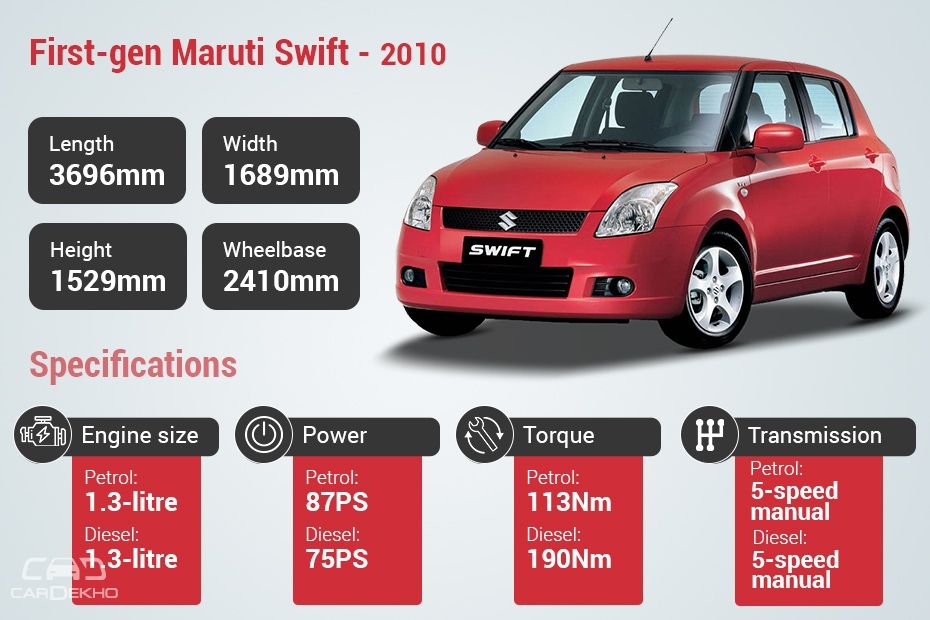Maruti Suzuki Swift Generation-wise Comparison: Tracing The Hatchback’s Evolution

Let’s take a look at all three generations of the Swift and see how this popular hatchback has evolved in its lifetime.
The first-gen Swift was introduced in India in 2005. Thanks to its relatively positive styling and feature-loaded package, it instantly caught the eyeballs of Indian customers. The success of the first-gen Swift was carried forward by its subsequent facelifts and the second-gen model that was introduced in 2011. And now, 13 years after its Indian debut, the Maruti Swift has received its 3rd generation update.
Let’s take a look at all three generations of the Swift and see how this popular hatchback has evolved in its lifetime.
First-gen Maruti Swift - 2005

When Maruti introduced the Swift hatchback in 2005, the most popular models on sale were the Maruti 800, Alto and Zen. All these were designed with a sleek silhouette, a lower roof height, and got an extremely basic feature list. Meanwhile, the first-gen Swift came with a unique, European styling, which helped it stand out from other hatchbacks in the market. The sweptback headlamps, rounded-off silhouette and a curvaceous side profile resulted in a design that was an optimum mix of cuteness and aggressiveness.
Inside, the first-gen Swift got a dark-grey colour scheme that made it look sporty and was easy to maintain. However, the darker shade also made the cabin feel claustrophobic for some. The limited space, especially at the rear, didn't help matters. The features weren't revolutionary either, though it did get airbags, anti-lock braking system, and a factory-fitted in-car entertainment system.
At the time of launch, the Swift came with a single engine option: a 1.3-litre, four-cylinder petrol that was earlier seen inside the Esteem sedan. At a time when most hatchbacks were running on 1.0-litre blocks, the larger engine in the Swift helped it become a heartthrob with enthusiasts. It had a free-revving nature and developed 88PS on tap. The slick-shifting 5-speed manual gearbox further accentuated the car's fun-to-drive capabilities and dynamics. In 2007, Suzuki struck a deal with Fiat, under which the latter supplied the 1.3-litre, four-cylinder DDiS diesel engines for the Swift, which further enhanced the target customer base of the hatchback.
Owing to the above strengths, the first-gen Swift became a bestseller in the B2 hatchback segment, with sales touching 2 lakh units in March 2008, 3 lakh in February 2009, and 5 lakh in January 2010.
Second-gen Maruti Swift - 2011
 When other carmakers started responding to the Swift's popularity with models like the Honda Jazz, Volkswagen Polo and Hyundai Elite i20, Maruti decided to roll out the second-gen model of the Swift in 2011. The new Swift had a sleeker exterior design, the headlamps were stretched back even more, and the increase in length and width helped make the Swift look a lot squatter.
When other carmakers started responding to the Swift's popularity with models like the Honda Jazz, Volkswagen Polo and Hyundai Elite i20, Maruti decided to roll out the second-gen model of the Swift in 2011. The new Swift had a sleeker exterior design, the headlamps were stretched back even more, and the increase in length and width helped make the Swift look a lot squatter.
While the exterior updates were evolutionary, changes on the inside were revolutionary. The all-grey theme gave way to an all-black scheme on a completely new dashboard design. Piano black and silver inserts made the Swift's cabin look and feel livelier. The quality of materials used as well as the cabin space saw a major upgrade, though the Swift still lagged in these departments compared to its competitors.
Maruti continued to offer the Swift with the same two engine options: the 1.2-litre petrol and the 1.3-litre diesel, both of which came with a 5-speed manual gearbox. However, due to changes in the chassis as well as mapping of the powertrain, the enthusiast-focused nature of the first-gen Swift was toned down. As a result, while the Swift's sales boomed, it lost the fun-to-drive image that the older Swift had.
Third-gen Maruti Swift - 2018

The third-gen Maruti Swift was introduced in early 2018. It is based on Suzuki's latest HEARTECT platform, which is claimed to be compliant with all mandatory safety regulations. According to the carmaker, the current Swift is the safest iteration of the hatchback so far. The new Swift also gets various modern features which has helped Maruti target younger customers and increase the car's desirability. These features include projector headlamps, LED daytime running lights and gunmetal alloy wheels. Its design is clearly an evolution of the previous model's, which helps in retaining its popular brand image while simultaneously giving it a fresh new look.
On the inside, the single-tone cabin layout has been retained. However, the all-black shade used here is lighter than the one in its predecessor. The third-gen model also gets increased usage of brushed silver accents and piano black inserts. The additional space, especially at the rear, has finally addressed the Swift's limited legroom problem as well. A new flat-bottom steering wheel, sporty twin-pod instrument cluster and a new automatic climate control console has helped liven up the cabin ambience.
However, the biggest highlight of the new Swift's interiors is the much-awaited touchscreen infotainment system. The 7-inch unit is similar to the one seen in other Maruti cars like the Ciaz, Baleno, Vitara Brezza, Ignis, and Dzire. It comes with Android Auto, Apple CarPlay and satellite navigation.
The third-gen Swift has also got an upgrade in the powertrain department. While the 1.2-litre petrol and 1.3-litre diesel engines have been carried forward without any major changes, Maruti has added an AMT automatic gearbox option on both these engines, in addition to the standard 5-speed manual gearbox. This has been done to serve the rising demand for affordable automatic hatchbacks in the Indian market.
 It is often said that the Swift name is a brand in itself, which is placed within the larger brand of Maruti Suzuki. The scale of confidence that the carmaker has on the Swift brand can be judged by the fact that there are no badges or stickers of the 'Maruti Suzuki' name on the third-gen model. The tailgate only has the Swift moniker and the Suzuki 'S' logo. This confidence isn't without reason either: In just over 2 months of its launch in February 2018, the new Swift managed to garner 1 lakh bookings, which is the fastest for any new car in the Indian market - a testament to the popularity and desirability of the hatchback.
It is often said that the Swift name is a brand in itself, which is placed within the larger brand of Maruti Suzuki. The scale of confidence that the carmaker has on the Swift brand can be judged by the fact that there are no badges or stickers of the 'Maruti Suzuki' name on the third-gen model. The tailgate only has the Swift moniker and the Suzuki 'S' logo. This confidence isn't without reason either: In just over 2 months of its launch in February 2018, the new Swift managed to garner 1 lakh bookings, which is the fastest for any new car in the Indian market - a testament to the popularity and desirability of the hatchback.
While the third-gen Maruti Suzuki Swift still has its share of limitations, it ticks most of the right boxes in an average Indian buyer's requirement list. As a result, despite tightening competition from outside as well as inside the company, the Swift continues to set the sales charts on fire to bring in around 20,000 unit sales every month.
From a car that once polarized opinions due to its strange bulbous design, to a brand name that is on every potential customer's option list, terming the Maruti Swift's evolution exponential is indeed an understatement.
Also Read: Maruti Swift 2018: New Vs Old – Major Differences
Read More on : Maruti Swift AMT
This Story has not been edited by ABP News. It has been published through cardekho.com feed directly.
Related Video
Breaking News: Delivery Crisis Today, Zomato, Swiggy, and Other Platforms Face Worker Strike






































